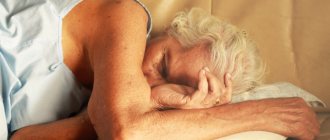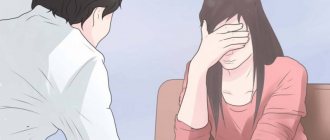OCD stands for obsessive-compulsive disorder. We are talking about neurosis associated with obsessive states. Habits that occur in many people and are even considered useful can cross an invisible line, turning into real mental disorders that prevent a person from living a normal life and require psychotherapeutic help.
OCD involves neurosis accompanied by obsessive-compulsive disorder
Common types of obsessions
In medicine, there are several obsessions characteristic of the disease:
- fear of various kinds of danger (fear of being robbed, fear of harming your family);
- fear of becoming infected (viruses, dirt, pesticides);
- anxiety due to lack of order, asymmetry and precision;
- various imaginations, obsessive thoughts about sex.
Against the background of haunting thoughts, a person resorts to compulsion and obsessive actions. This allows you to temporarily reduce tension, anxiety, and get rid of obsessive thoughts.
Behavior
Patients with OCD are suspicious people, prone to rare, extremely decisive actions, which is immediately noticeable against the background of their dominant calm. The main signs are painful stereotypical, intrusive (obsessive) thoughts, images or desires, perceived as meaningless, which in a stereotypical form come to the patient’s mind again and again and cause an unsuccessful attempt at resistance. Their typical topics include:
- fear of infection or contamination;
- fear of harming yourself or others;
- sexually explicit or violent thoughts and images;
- religious or moral ideas;
- fear of losing or not having some things that you may need;
- order and symmetry: the idea that everything should be lined up “correctly”;
- superstition, excessive attention to something considered as good or bad luck.
Compulsive actions or rituals are stereotypical behaviors repeated over and over again, the meaning of which is to prevent any objectively unlikely events. Obsessions and compulsions are more often experienced as alien, absurd and irrational. The patient suffers from them and resists them.
Factors and reasons
It is difficult to name the main cause of OCD syndrome, since both physiological and psychological factors are responsible for such an unhealthy disorder of the nervous system:
- Genetic predisposition.
- Infection with group A streptococcal infection in childhood, which provokes inflammatory processes and leads to dysfunction of the basal ganglia. In medicine, this phenomenon is called pediatric autoimmune neuropsychiatric disorder. Also, the cause of OCD can be the body’s immunological reaction to various pathogenic microflora (viruses, bacteria, fungi).
- In patients with this syndrome, certain areas of the brain have unusual activity. Such people suffer from increased aggression and sexual preoccupation. They are characterized by bodily discharge. These disorders are caused by decreased activity of serotonin and glutamate.
- Constant avoidance. A person diagnosed with OCD is in fear and tries to avoid danger. To get rid of obsessive thoughts about her from his head, he begins to perform compulsive rituals that eliminate anxiety. The risk group includes people who have experienced severe stress: a change of job, a break in a relationship with a loved one, or severe mental and physical fatigue.
- Obsessive-compulsive disorder develops in people who have suffered serious psychological trauma: violence, serious illness, death of a loved one, moving to a new place of residence, problems in the family or at work.
Diagnosis and treatment
The symptoms of obsessive-compulsive disorder are very similar to schizophrenia, especially if the patient has unusual thoughts and eccentric ritual actions. It is also important how the patient perceives his thoughts - as his own or as imposed. For this reason, the disease should be treated exclusively by a specialist who can differentiate the disease and make an accurate diagnosis.
To identify the disease, a special test for obsessive-compulsive disorder (Yale-Brown scale) is used. It consists of 10 questions, the first five of which allow us to understand whether the patient really has OCD and how often he has obsessive thoughts, and the second five give an understanding of how much the rituals performed affect the patient’s life.
Psychotherapy
This is a classic method that is used for milder cases of the disease.
Of all the psychotherapeutic methods, the best effect in treating this syndrome is provided by:
- cognitive behavioral psychotherapy;
- short-term strategic psychotherapy;
- EMDR therapy;
- hypnosis.
Psychotherapists claim that this method of treatment helps in 75% of cases.
Cognitive behavioral psychotherapy
This technique is developed according to the type of training for each patient individually. To determine the severity of the disease, the psychotherapist uses various tests and scales. The doctor also monitors all the patient’s OCD symptoms.
After this, the specialist applies the technique of exposure therapy. The patient is exposed to fear from a list of symptoms and his condition and actions are observed. In the intervals between such sessions, the patient must independently perform work aimed at combating this fear.
There is another effective technique - imaginary representations. The patient and therapist create short stories in which they talk about obsessive thoughts and actions. The conversation is recorded on a voice recorder, after which the patient listens to it. This approach allows him to dose out his experiences and learn to deal with them.
Short-term strategic psychotherapy
The goal of this technique is to achieve a therapeutic effect as quickly as possible without studying the causes of the syndrome.
First, the doctor gains the patient’s trust in order to convince him of the effectiveness of this treatment method. Then he develops special exercises for the patient to eliminate obsessive states.
Usually, 10 sessions, which last from 20 to 60 minutes, are enough for complete treatment. This therapy helps treat even the most chronic and severe forms of the syndrome.
EDMR therapy
This therapy is based on reducing sensitivity and changing eye movements. This is a very effective technique that helps reduce the intensity of emotional experiences and speed up the natural process of processing information.
In addition to eye movements, EDMR therapy includes sounds (alternating between the right and left ears) and tapping.
Session duration is 1-1.5 hours, number from 2 to 16 sessions. This treatment method is contraindicated for patients suffering from epilepsy and psychotic conditions.
The therapeutic technique works well to treat OCD in people who have suffered a terrorist attack, war, car accident and violence.
It is one of the most effective methods of treating obsessive disorders.
The patient's body is put into an artificial state of drowsiness or sleep, which leads to inhibition of consciousness and unconscious execution of various commands.
The main goal of hypnosis is to cure neurosis. There are two methods of hypnotic therapy:
- Directive persuasion. The goal of such therapy is to change the patient's thoughts and actions, which helps him overcome fear. The person is also introduced to new behavior options that replace obsessive actions.
- Indirect beliefs. New thought patterns are instilled in the patient, which are reinforced at both the conscious and unconscious levels.
- Methods of regression, progression and confusion are used to distort time and embed the necessary suggestions. This approach allows the patient to quickly and painlessly cope with OCD syndrome.
How to get rid of OCD
Psychotherapy ceases to be something terrifying and frightening, and people talk more and more openly about the problems that bother them. And this is the first step towards healing. But in order to completely get rid of OCD, it is necessary to fulfill some other conditions.
Anancastic personality disorder and obsessive-compulsive disorder are two different OCDs.
It's easy to get confused with medical terminology. Nevertheless, it is important for the patient to understand what kind of disorder he has:
| Type of disorder | Peculiarities | Characteristic symptoms |
| Anancastic personality disorder (obsessive-compulsive personality disorder) | Pathology refers to personality disorders, that is, it characterizes the patient’s personality type or behavioral tendencies characteristic of him that differ from the norm. |
|
| Obsessive-compulsive disorder (obsessive-compulsive disorder) | Pathology belongs to the group of mental disorders. It can be episodic, progressive or chronic. |
|
Since anancaste personality disorder is “built-in” into a person, it cannot be cured. Therapy in this case is aimed at reducing the severity of symptoms and mitigating them.
The prognosis is generally favorable, although the attending specialist must be able to establish contact with difficult patients.
Anancasts on a subconscious level resist the will of the psychotherapist, trying to overthrow his authority.
Obsessive-compulsive neurosis is more amenable to correction. It is on getting rid of this type of OCD that a person can focus even on his own (although the help of a doctor will not be superfluous).
OCD: how to get rid of rituals using breaks
To get rid of OCD, it is recommended to periodically skip rituals. For example, a person was “attacked” by an obsessive thought about the need to urgently wash his hands. Instead of rushing to the sink, you should skip this attack. Let the pause last one or two minutes, but it will happen.
It is recommended to gradually increase the number of breaks. It will be difficult at first: you should be prepared for this.
A good option is to immediately engage in some small and useful task when an obsession arises: wash a plate, comb your hair, wipe the dust from a shelf.
In this way, the mind will be distracted from the obsessive thought and, at least for a while, will stop worrying about the troubles that can happen if the compulsion is not fulfilled.
At the same time, it is important to always remember past experience: if nothing bad happened when a person skipped rituals before, then in the same way nothing bad will happen in the future. You must always keep your mind cool and control your thought process without panicking.
How to get rid of OCD by reducing the time of rituals
OCD greatly interferes with life. And since it is unlikely that you will be able to quickly get rid of the disorder, you should at least minimize its impact on your daily routine.
Whatever ritual a person is inclined to, he needs to reduce the duration of the procedure:
- wash your hands not twenty times, but ten;
- reread three lines of a letter not for half an hour, but for five minutes;
- check the switches not seven times, but only three times, etc.
You should not chase any “standard” for reducing time. Reducing the duration of the ritual by even one conventional unit is already progress that you can be proud of. When the new duration becomes a habit, you should “shorten” the compulsion a little more. And so on until victory.
How to Get Rid of OCD by Accepting Intrusive Thoughts
With obsessive-compulsive neurosis, most patients strive with all their might to stop the obsession. This is why they perform meaningless, exhausting rituals.
You can try another way. You should not try to interrupt the obsessive thought, but calmly think it through to the end. This is akin to meditation: relax, give yourself time and analyze the information that comes to mind:
- How does obsession change if you don’t respond to it?
- how long does it last?
- What bodily symptoms and emotional reactions does it provoke?
It is recommended to “roll” the obsession in your head, allowing it to develop from beginning to end. And it’s okay if you don’t have enough patience and have to perform a compulsion: next time it will work out better.
With OCD, it is important not to blame yourself and to accept your characteristics as kindly as possible. Obsessive-compulsive neurosis is a disease for which obsessions and compulsions are absolutely natural.
Their occurrence is poorly controlled, so a person is not obliged to engage in self-flagellation for his own justification.
He should devote internal resources not to self-torture, but to attempts to “curb” OCD through its acceptance.
Is it possible to get rid of OCD forever?
The prognosis for OCD is generally positive in the sense that there is a chance of symptom relief. The danger of neurosis is its transition to a chronic form with periodic exacerbations. But it depends on the case: mild disorders can sometimes be completely cured, and acute OCD often does not recur.
If independent attempts do not produce results, you should contact a specialist. Treatment includes two main areas:
- Psychotherapy. Methods of cognitive behavioral therapy are widely used, allowing the patient to learn to resist obsessions and refuse to perform labor-intensive rituals. The technique of stopping thoughts can be used. Sometimes a psychotherapist deliberately places a person in an uncomfortable situation so that he tries not to react to intrusive thoughts that arise.
- Drug treatment. For OCD, patients are prescribed antidepressants, the main one being clomipramine. To relieve severe anxiety, benzodiazepine tranquilizers (clonazepam, phenazepam) are prescribed. Atypical antipsychotics (quetiapine) are sometimes indicated.
Taking medication is a last resort because OCD symptoms return after stopping the medication. The main emphasis is on psychotherapy. Also useful for the patient:
- compliance with the work and rest schedule;
- moderate physical activity;
- relaxing baths.
Obsessive-compulsive disorder is an extremely difficult disorder for the person himself. And since it is prone to progression, measures must be taken immediately. The earlier the better.
Source: https://fobia.su/kak-izbavitsya-ot-okr.html
Drug therapy
Treatment with medications is used if psychotherapy is powerless.
The patient is prescribed effective anti-resistant drugs:
- antidepressants;
- other psychotics;
- preparations containing lithium;
- Inositol with increased dosage;
- setrons;
- Memantine, Afetylcysteine and other drugs of similar action;
- Omega-3.
Antidepressants
You can fight depression and reduce anxiety with the help of SSRI antidepressants. They inhibit serotonin reuptake. The best drugs in this group include:
- Fluvoxamine. It has a calming effect, improves mood and normalizes the functioning of the autonomic system. This drug is prescribed for anxiety and depression. It is not recommended to take this drug yourself at home, since it has a number of side effects: nausea, vomiting, dizziness, abdominal pain, anorexia and insomnia.
- Sertraline. Helps cope with panic attacks, depression and obsessive-compulsive disorder. Contraindicated for epilepsy, liver and kidney failure, during pregnancy and for children under 6 years of age.
- Fluoxetine. A complex action drug that eliminates feelings of anxiety and deep depression in OCD syndrome. It has a number of side effects: headaches, weakness, asthenia, increased excitability.
- Paroxetine. An effective drug that helps cure neurosis. It has the same side effects as the drug Fluvoxamine. Additionally, the risk of developing suicidal thoughts increases in both adults and children. Therefore, it is contraindicated to use it independently at home without a doctor’s prescription.
Diagnosis: visit to the doctor
People suffering from obsessions and compulsions do not always suspect their own illnesses. However, those around them - relatives, acquaintances, colleagues - should carefully point this out to them: they should not expect that the illness will go away on its own.
Diagnosis can only be carried out by a professional psychologist. The diagnosis of OCD and determination of the degree of the disorder is made using special rating scales, which can be deciphered by a qualified specialist.
OCD should be treated by a qualified physician
Here's what the therapist should pay attention to first:
- The presence of pronounced obsessive obsessions (which are already a sign of a disorder).
- Signs of compulsive neurosis, which the patient, nevertheless, tries to hide.
- Disruption of the normal rhythm of life.
- Difficulty communicating with colleagues and friends.
Symptoms are considered significant for accurate diagnosis if they recur 50 percent of the time over a couple of weeks.
The doctor examines the patient, talks with him, gives special tests and makes a diagnosis. He must explain to the person:
- what does obsessive-compulsive disorder mean?
- by what symptoms can it be identified?
- what are the causes of this problem;
- what should be the treatment – medication and psychological.
You should not think that the disease is incurable - in fact, many people manage to successfully cope with disorders and return to normal life, not burdened by obsessive states.
Is it possible to cure the described disease at home? Theoretically, it is possible to cope with a problem if it is detected at a very early stage of development, the patient himself recognizes it, accepts it and does everything necessary to recover.
Here are therapy options that you can do yourself:
- Learn more about OCD, its symptoms and causes. There is specialized literature for this, the Internet (this site, in particular). Write down symptoms that cause particular concern. Developing a strategy to deal with these symptoms.
- Look fear straight in the eye. Most patients are aware of the irrationality of obsessive states, their “fictional” nature. And if you want to wash your hands again or check if the door is closed, you need to remind yourself of the futility of such actions and psychologically force yourself not to perform them.
- You should praise yourself for every successful step, even if it was insignificant.
Although, of course, it is better to contact a qualified medical psychotherapy specialist. There may be some difficulties at the first visit to the doctor, but once he makes a diagnosis, prescribes treatment, everything will be much easier.
Worth seeing: Anxious Obsessions
Some folk remedies help patients calm down: these are decoctions of lemon balm, valerian and other sedative herbs.
Breathing exercises are also considered useful. All that is required is to correctly change the force of breathing. This gradually restores a normal emotional state and makes a person’s assessment of everything that happens in his life more sober and adequate.
How does obsessive-compulsive disorder manifest?
What happens? Is it no longer normal to strive for cleanliness, hygiene and sanitation? Not at all, but in everything you need to know when to stop. It’s normal if the house is clean and things are in their places. But if a person is fixated on the fact that the sugar bowl should be located next to the salt shaker strictly to the left - not in front, not behind, not on the right and not next to the pepper shaker - then, you see, this is already strange.
In fact, the example described is one of many manifestations of obsessive-compulsive mental disorder. There are so many forms of OCD that it is quite difficult to give them a clear classification. But it’s still worth highlighting the main ones.
What is OCD?
Along with phobias, OCD is classified as an obsessive disorder (phobias and compulsions are part of the structure of this syndrome), but unlike phobic manifestations, they include obsessions (obsession) and compulsions (compulsion).
Most often, this disease occurs between the ages of 10 and 35. Several years may pass from the onset of the disease to the appearance of its initial severe symptoms. Among adults, OCD occurs in every third person (in a more or less pronounced form); among children, every second person in five thousand is affected.
At first, the person realizes the irrationality of his obsessive state, but if he does not receive any psychological and, possibly, medical help, a further exacerbation of this disorder occurs. The patient is no longer able to adequately assess the situation.
Where do legs grow from: causes of OCD
The causes of obsessive-compulsive disorder are never obvious. They are associated with deep psychological trauma, certain attitudes and prohibitions. Strict upbringing, a strict system of sanctions for disobedience, a stressful family environment, social taboos, and ridicule lead to obsessive-compulsive neurosis. In other words, OCD occurs where there is an acute internal struggle between “I want” and “I can’t.” Let's look at an example.
Evgenia is a teenage girl who suffers from excess weight. This worries her greatly - all her classmates are beautiful, slender, many already have boyfriends. The situation is aggravated by ridicule from peers. On this basis, psychotrauma arises, which in the future may turn into OCD.
The girl begins to be haunted by thoughts: “I’ll show them all! They will still envy me.” And he begins to lose weight. At some point, thoughts about self-improvement are so captivating that Zhenya goes beyond the norm and now suffers from underweight.
Of course, not every such situation will necessarily develop into obsessive-compulsive disorder. People who are emotional, anxious, fearful, avoid conflict, pedantic, and prone to self-improvement are more prone to it.
In addition to social causes, there are other causes of OCD: diseases of the central nervous system, trauma, disruption of neural interaction in the brain.
Alexander FEDOROVICH
Another study was conducted by American scientists. Experts at Binghamton University have found that lack of daylight can exacerbate symptoms of obsessive-compulsive disorder (OCD). What kind of illness is this? Why is he dangerous? What are the treatments?
Obsessive-compulsive disorder is an initial obsession with thoughts that turns into various actions that are also obsessive in nature. Thoughts and actions are connected.
Thoughts are something that a person cannot get rid of, and obsessive actions should help him. People often do very strange things. For example, they are afraid of contracting an infection, getting sick, or becoming a carrier of some unpleasant things. And then they start washing their hands 18 times after they’ve thought about it. Or they are locked with a lock with three turns - not two, not four, but three. Because it is the number three that can save them. And you also have to count everything. And if it doesn’t work out, you have to do everything again. This is what it looks like, I am describing a real clinical variant.
I consider the assertion of American scientists that a lack of daylight can aggravate OCD symptoms to be unfounded.
This is as “correct” a thought as the fact that peppermint candies have a very good effect on various experiences. Like, a person gets distracted, unwraps the wrapper, it’s so green, and the person is distracted from his problems.
Factors that influence OCD can be absolutely anything. It is pointless to talk about what affects the symptoms of OCD, since the factors can be absolutely anything. Moreover, applying any therapy to patients with OCD is also problematic, since the necessary medications are very few.
And rational psychotherapy does not work, because it is not possible to explain to a person that he is doing something wrong. He is convinced that he is doing everything right. The only thing he has doubts about is.
OCD does not exist in isolation from something. For example, linking to an account can be completely total.
Everything can become obsessive - from red cars passing by to the sum of house numbers that a person walks or drives past. Therefore, the therapeutic basis is a matter of diagnosis and understanding within which disorder all this exists. But there are always limits.
The vast majority of mental illnesses are genetic. As a rule, a person suffering from OCD has inherited some character traits or characteristics from his parents that naturally influenced the formation of obsessive-compulsive experiences.
Which celebrities suffered from OCD?
The famous writer Nikolai Gogol often wrote letters to his loved ones, where he constantly complained about his health. He was a very sick man - he suffered from purulent otitis media in both ears, bronchitis, scarlet fever, scrofula, hemorrhoids and even cholera. However, many researchers attributed OCD to the writer. In addition, Gogol was often tormented by visual and auditory hallucinations, and periods of apathy were replaced by excitement. In addition, the writer suffered from hypochondria and claustrophobia. And researchers believe that the cause of Gogol’s sudden death was nervous exhaustion to which he brought himself.
Some experts claim that Nikolai Gogol also suffered from OCD. Footballer David Beckham has been diagnosed with obsessive-compulsive disorder because he cannot calm down until all his belongings are in their usual places. Maintaining constant order helps him cope with the problem.
Hollywood actor Leonardo DiCaprio also suffers from OCD. In an interview, he said that he was diagnosed with this illness as a child, and he almost did not suffer from it until he played the role of Howard Hughes - a man who also suffered from mental disorders - in the film “The Aviator”.
Famous Hollywood actor Harrison Ford began developing symptoms of OCD in the late 1960s. Like Beckham, he strove for order and accuracy in everything. For example, as soon as Ford drank a cup of tea, he immediately put it away, and leaving a cup or a crumpled napkin caused him to have a concentration disorder and he began to get nervous.
4 million - this is how many people with obsessive-compulsive disorder live in Russia, according to some studies. Many of them do not even know that they are sick.
What exactly is the problem?
It seems like a man lives for himself and washes his hands. And to your health! Of course, it makes sense to worry when it comes to alcohol, drug addiction and other extreme manifestations. But in general, you can live.
Can. But it's difficult. Obsessive-compulsive disorder is a trap of our subconscious. At the initial stage, the person took some action and relieved internal tension. But gradually you have to discharge more and more often. And now you need to wash your hands not 10, but 20, 30, 40 times a day. And this is a problem that causes significant discomfort: work, family, relationships with loved ones fade into the background. It becomes difficult to concentrate on anything other than your neurosis. Therefore, it is better to consult a psychotherapist in a timely manner.
Treatment of obsessive-compulsive disorder
The doctor selects the course of treatment according to the severity of the disorder (OCD can be a symptom of mental disorders). There are 3 main components.
Drug therapy
It is treated with the use of psychotropic drugs: antidepressants, tranquilizers, drugs that relieve symptoms of obsession and anxiety. General strengthening drugs (vitamins) are also prescribed.
Psychotherapy
Aimed at eliminating obsessive actions, searching deeply for the root cause of the disorder and solving it.
The second task of the psychotherapist is to prevent the reappearance of neuroses. That is, teach the patient techniques for relieving tension, calm attitude towards certain situations, etc.
Additional Methods
Their goal is to relax and stabilize the nervous system. These can be breathing techniques, relaxation, hydrotherapy, meditation, physiotherapy.
Non-medical methods are also used to restore patients with OCD: music, drawing, clay modeling, etc. You should not be surprised if the doctor suggests getting a pet. Animal therapy can often help relieve the stress, tension, and anxiety associated with people with OCD.
If obsessive thoughts and actions interfere with life for you or your loved ones, make an appointment with psychotherapists at Best Clinic. Look deep into yourself, deal with what torments you, learn to look at things from a different angle and focus on what is really important! Our doctors will help you.
Symptoms of the disorder
The diagnosis of OCD suggests different types of this disorder, but their overall clinical picture is almost the same. First of all, we are talking about painful thoughts and fantasies associated with:
- sexual violence;
- imminent death;
- loss of financial well-being, etc.
Even realizing the groundlessness of such ideas, the patient still cannot free himself from them. It seems to him that these fantasies will one day become reality.
The main symptoms of this mental disorder are associated with the repetition of the same movements. Some people count steps everywhere, others never tire of washing their hands several dozen times a day. It’s hard for others around you – colleagues, friends and relatives – to ignore this behavior.
Often, people with OCD syndrome keep their workplace in perfect order: the symmetrical placement of all objects is striking. Books in a bookcase can be sorted by alphabetical order or color.
When the patient finds himself in a crowd, the signs of his distress intensify and panic attacks begin. There may be a fear of infection with some terrible virus, fear of losing personal belongings or having them stolen. Accordingly, such people should visit public places as rarely as possible.
Worth seeing: Religious OCD
Possible decrease in self-esteem. In general, suspicious individuals often have to suffer from compulsive-obsessive disorder: with a tendency to control everything they do, they suddenly realize that certain changes are taking place and they have no way to influence it.











